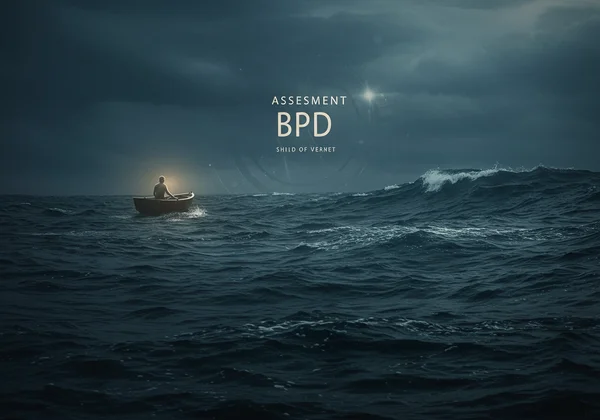BPD Test & Boundaries: A Guide for Loved Ones
Loving someone with Borderline Personality Disorder (BPD) can feel like navigating a beautiful but stormy sea. The connection can be incredibly deep and intense, yet the emotional waves can leave you feeling exhausted, confused, and constantly on edge. You might find yourself "walking on eggshells," carefully measuring every word and action to avoid an outburst. If this sounds familiar, you're not alone, and there is a path toward a more stable relationship. Understanding the symptoms, perhaps even through a preliminary BPD test, is a first step, but the next crucial action is learning to set healthy boundaries. This guide aims to help you reclaim your well-being and foster a more balanced connection.

This guide is designed to provide you with compassionate, practical strategies for establishing the boundaries necessary for both your mental health and the health of your relationship. Setting boundaries isn't about punishment or control; it's about creating a structure of respect and safety where a healthier dynamic can grow. For a deeper understanding of the symptoms that make this so challenging, you can learn more here.
Understanding BPD Relationships: The Role of a BPD Test and Boundaries
Before diving into the "how," it's essential to understand the "why." BPD is characterized by intense emotional dysregulation, a deep-seated fear of abandonment, and an unstable sense of self. These core symptoms, which can be initially identified through a comprehensive BPD test online, create a relational dynamic where boundaries can feel threatening to the person with BPD, making it incredibly difficult for loved ones to establish and maintain them.
The Unique Challenges Faced by Those Supporting a BPD Partner or Family Member
As a loved one, you may experience a unique set of challenges. You might be the target of intense anger or rage, only to be placed on a pedestal hours later. This cycle of idealization and devaluation can be incredibly disorienting. The fear of triggering your loved one's abandonment fears can lead you to sacrifice your own needs, wants, and limits. This constant self-abandonment is a fast track to emotional burnout, resentment, and a feeling of losing your own identity within the relationship. You become a caretaker first and a partner, friend, or family member second.
How Porous Boundaries Can Impact Your Mental Health and the Relationship Dynamic
When boundaries are weak or nonexistent—what we call "porous boundaries"—the consequences are severe. Your mental health suffers as you absorb the emotional volatility of your loved one. Anxiety, depression, and chronic stress become your new normal. The relationship itself becomes defined by crisis and appeasement rather than mutual respect and growth. Without clear lines, your loved one doesn't have a stable structure to interact with, which can paradoxically increase their insecurity and emotional outbursts. Healthy boundaries provide the predictability and safety that both of you desperately need.

Practical Steps to Establish Healthy BPD Boundaries
Before diving into practical steps, understanding your BPD symptoms through a reliable BPD test can provide valuable self-awareness. Creating effective boundaries is a skill that calls for thought, practice, and courage. It’s never a single conversation, but rather an ongoing journey. Here are the foundational steps to get you started on creating healthier BPD relationships.
Identifying Your Personal Needs and Limits (Prioritizing Self-Care)
You cannot enforce a boundary you haven't defined. The first and most crucial step is to look inward. What do you need to feel safe, respected, and sane? This involves deep self-reflection.
-
Emotional Limits: Are you available to talk through every crisis, or do you need to state that you cannot discuss emotionally charged topics after 10 PM?
-
Behavioral Limits: Are you okay with raised voices? What about impulsive spending that affects shared finances?
-
Time and Energy Limits: You are not a 24/7 therapist. You need time for your own hobbies, friends, and rest. Prioritizing self-care isn't selfish; it's a prerequisite for being a supportive presence in anyone's life. When you're running on empty, you have nothing left to give.

Communicating Your Boundaries Clearly, Calmly, and Compassionately
The delivery of your boundary is just as important as the boundary itself. The goal is to be firm yet kind, clear but not critical.
- Use "I" Statements: Frame the boundary around your needs, not their behavior. Instead of "You can't yell at me," try "I feel scared and can't continue this conversation when your voice is raised. I am going to step away until we can both speak calmly."
- Be Specific and Concise: Vague boundaries are easy to misinterpret. "Be more respectful" is unclear. "Please don't read my private journal" is crystal clear.
- Choose a Calm Moment: Do not try to set a new boundary in the middle of a heated argument. Wait for a moment of relative peace to have the conversation. Making this a part of healthy communication is vital.
What to Expect When Setting Boundaries and How to Respond Consistently
When you first introduce a boundary, especially in a long-established dynamic, expect pushback. Your loved one may test the boundary, interpreting it as rejection or abandonment. They might become angry, plead, or try to induce guilt. This is where your resolve is critical. Consistency is the key to making a boundary real. If you state you will leave the room when yelling starts, you must do it every single time. Caving in teaches them that the boundary is negotiable. Prepare yourself emotionally for this testing phase; it's often the hardest part, but it's essential for long-term change.
Sustaining Your Boundaries and Seeking Further Support
Setting a boundary is an event; holding it is a practice. It requires ongoing effort and a strong support system to maintain your resolve and navigate the complexities of a BPD relationship.
The Role of Patience, Persistence, and Self-Validation
You will make mistakes. There will be days you don't hold the line perfectly. This is normal. The key is patience with yourself and the process. Each time you successfully hold a boundary, you are reinforcing a healthier dynamic. It's also crucial to practice self-validation. You are not being mean or selfish; you are being healthy. Remind yourself that your needs are valid and that setting boundaries is the most loving thing you can do for the relationship in the long run. To better grasp the scope of BPD symptoms, taking a free BPD test can provide valuable context.
When and Where to Seek Professional Guidance for Family Support
You cannot do this alone, nor should you have to. A therapist specializing in BPD or family dynamics can provide invaluable guidance and support. They can help you refine your boundary-setting skills, manage feelings of guilt, and develop coping strategies. A therapist can also help you interpret the results of an online BPD test or guide you through a formal assessment process. Consider seeking out support groups for families and partners of individuals with BPD, such as those offered by NAMI (National Alliance on Mental Illness). Connecting with others who understand your experience provides validation and reduces feelings of isolation. A BPD symptoms quiz can be a helpful starting point to frame a conversation with a professional.

Building Stronger, Healthier Relationships Through Boundaries
Establishing healthy BPD boundaries is a challenging but transformative journey. It is an act of profound love for yourself and for the person you care about. By creating structure, you reduce chaos. By protecting your well-being, you ensure you can remain a supportive and loving presence in their life. You are not abandoning them; you are teaching them how to be in a healthy, respectful relationship with you.
This process is a marathon, not a sprint. Be kind to yourself, celebrate small victories, and continue seeking knowledge. Understanding the full picture of Borderline Personality Disorder is key. Our platform offers a free and anonymous BPD test to help you begin this journey. If you are looking for a scientifically-informed starting point, consider exploring the resources at BPDTest.me.
Frequently Asked Questions About BPD Boundaries and Support
How do I know if I'm "walking on eggshells" in a BPD relationship?
"Walking on eggshells" is a feeling of constant anxiety where you're afraid to say or do the "wrong" thing for fear of causing an unpredictable, negative emotional reaction. Signs include constantly censoring yourself, avoiding certain topics, feeling responsible for your loved one's emotions, and prioritizing their emotional state over your own needs.
What triggers BPD rage, and how can I set boundaries during an episode?
Triggers for BPD rage often stem from a perceived threat of abandonment, rejection, or criticism. During an episode of intense emotion, the priority is de-escalation and safety, not setting a new boundary. Your boundary in that moment might be to state calmly, "I can see you're very upset. I am going to give us both some space, and we can talk about this later when things are calmer." The key is to remove yourself from the situation, not to engage in the argument.
Can setting boundaries make my loved one's BPD symptoms worse?
Initially, it might seem that way. Setting a boundary can trigger intense fear of abandonment, leading to a temporary escalation of behaviors (like anger or pleading) as your loved one tests the new limit. However, consistently holding firm, healthy boundaries over time provides the structure and predictability that can actually help reduce emotional dysregulation. It is a necessary step for long-term relationship health.
Where can family members of individuals with BPD find additional support?
You are not alone. Organizations like the National Alliance on Mental Illness (NAMI) and the National Education Alliance for Borderline Personality Disorder (NEABPD) offer resources, classes, and support groups specifically for families. Online forums and local therapy groups can also be invaluable. For a foundational understanding of BPD, a resource like the online BPD quiz can be an excellent first step in your educational journey.